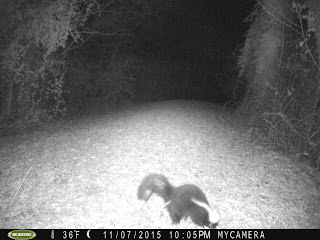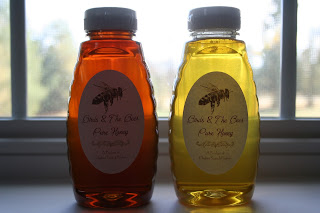Three weeks ago we checked the progress of the bees, knowing that we're very quickly coming to the end of the honey season. As of three weeks ago the frames still were not full nor capped. Three weeks time apparently made a huge difference for the bees. The weather was nice and warm during that time and the field behind the hives were full of awesome wild flowers.
Last year was our first time to pull honey from our hives and we've learned a few things from that experience that we don't want to repeat. Last year we took the honey frames from the hive, trying to smoke and brush the bees away and take the frames to the house. By the time we had all the frames at the house, we also had the entire bee colony at our front door eating honey as fast as they could and taking it back to the hive. It was very hectic, crazy, honey harvesting.
Before we began the process this year we did a little research on how to get the bees out of the honey super the day before the harvest. We looked at several different options and the one that sounded the easiest with good results was to use a bee escape. It works like a one way door to let the bees out of the honey super but won't let them back in.
Place the bee escape on the inner cover, place the inner cover under the honey box that you want the bees out of. The bees go down the little hole but can't come back up.
The bee escape worked very well and we're able to take the honey supers with out much resistance.
Just in case the bees decided to follow we had a plan this time. Larry was to throw the box on the four wheeler, at break neck speed take it into the Morton building and shut the door behind him. The plan worked well, we got all the honey into the building without a swarm of bees.
We don't yet own a honey extractor so we scrapped the comb and honey from the frames. This is not the best way to extract honey because it destroys the comb that the bees could just refill if we had used an extractor. It essentially makes more work for the bees, they will now need to rebuild the comb. I will be able to use the comb in soap and hope to make a few candles.
We used a food grade bucket and a strainer to catch the honey and comb.
As we pulled the frames from the box we began to notice the difference in the honey colors from frame to frame. It was so interesting.
This particular frame had super dark honey, that looked like molasses right in the center and very light yellow honey all around. That's when I decided we needed to keep the different colors separate. Men really love it when you suddenly change up the process in the middle of what they're doing. You women know what I'm talking about. So we began the process of scrapping dark honey into one bucket and light yellow into another. In the long run he thought it was probably a good idea.
Look at the difference in the colors. We're straining the honey into the buckets. We left it over night, it's a slow process but works well.
The next morning it was ready to strain one last time.
All I can say is yum!
I think the dark molasses colored honey is from a field of Goldenrod just behind our house. It sure makes some good honey!
Proverbs 16:24
Pleasant words are like honeycomb, Sweetness to the soul and health to the bones.
Have a Blessed day!
Angie




















































